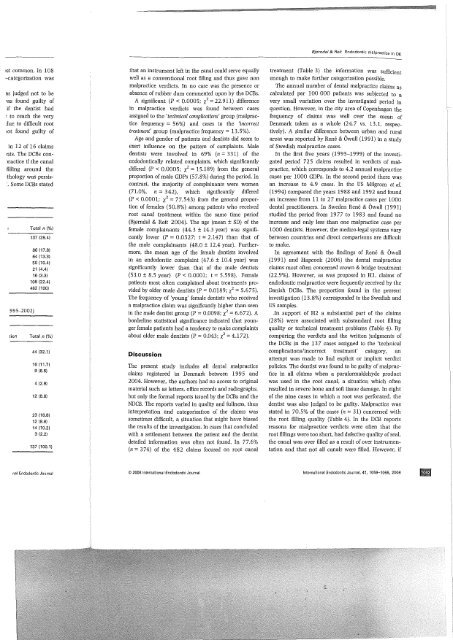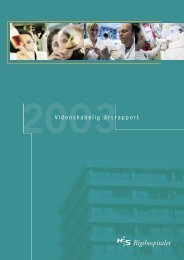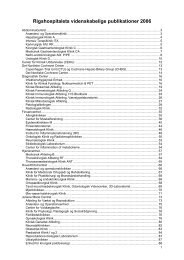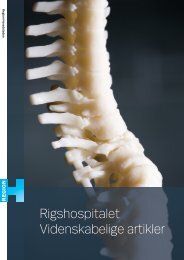View - CTU
View - CTU
View - CTU
You also want an ePaper? Increase the reach of your titles
YUMPU automatically turns print PDFs into web optimized ePapers that Google loves.
Bf¢rndal & Reit Endodontic malpractice in DK<br />
1st common. In 108<br />
'-categorization was<br />
as judged not to be<br />
ras found guilty of<br />
if the dentist had<br />
' to reach the very<br />
:lue to difficult root<br />
tot found guilty of<br />
in 12 of 16 claims<br />
nts. The DCBs con<br />
>ractice if the canal<br />
filling around the<br />
thology was persis<br />
'.. Some DCBs stated<br />
995-2002)<br />
Total n (%)<br />
137 (28.4)<br />
86 (17.8)<br />
64 (13.3)<br />
50 (10.4)<br />
21 (4.4)<br />
16 (3.3)<br />
108 (22.4)<br />
482 (100)<br />
tion Total n (%)<br />
44 (32.1)<br />
16 (11.7)<br />
9 (6.6)<br />
4 (2.9)<br />
12 (8.8)<br />
23 (16.8)<br />
12 (8.8)<br />
14 (10.2)<br />
3 (2.2)<br />
137 (100.1)<br />
that an instrument left in the canal could serve equally<br />
well as a conventional root fiiling and thus gave non<br />
malpractice verdicts. In no case was the presence or<br />
absence of rubber dam commented upon by the DCBs.<br />
A significant (P < 0.0005; x2 = 22.911) difference<br />
in malpractice verdicts was found between cases<br />
assigned to the 'technical complications' group (malpractice<br />
frequency = 56%) and cases in the 'incorrect<br />
treatment' group (malpractice frequency= 13.5%).<br />
Age and gender of patients and dentists did seem to<br />
exert influence on the pattern of complaints. Male<br />
dentists were involved in 69% (11 = 331) of the<br />
endodontically related complaints, which significantly<br />
differed (P < 0.0005; x2 = 15.189) from the general<br />
proportion of male GDPs (57.8%) during the period. In<br />
contrast, the majority of complainants were women<br />
(71.0%, n = 342), which significantly differed<br />
(P < 0.0001; x2 = 77.543) from the general proportion<br />
of females (50.8%) among patients who received<br />
root canal treatment within the same time period<br />
(Bj0rndal & Reit 2004). The age (mean ± SD) of the<br />
female complainants (44.3 ± 14.3 year) was significantly<br />
lower (P = 0.0327; t = 2.147) than that of<br />
the male complainants (48.0 ± 12.4 year). Furthermore,<br />
the mean age of the female dentists involved<br />
in an endodontic complaint (47.6 ± 10.4 year) was<br />
significantly lower than that of the male dentists<br />
(53.0 ± 8.5 year) (P < 0.0001; t = 5.598). Female<br />
patients most often complained about treatments provided<br />
by older male dentists (P = 0.0189; x 2 = 5.675).<br />
The frequency of 'young' female dentists who received<br />
a malpractice claim was significantly higher than seen<br />
in the male dentist group (P = 0.0098; x2 = 6.672). A<br />
borderline statistical significance indicated that younger<br />
female patients had a tendency to make complaints<br />
about older male dentists (P = 0.043; x2 = 4.172).<br />
Discussion<br />
The present study includes all dental malpractice<br />
claims registered in Denmark between 1995 and<br />
2004. However, the authors had no access to original<br />
material such as letters, office records and radiographs,<br />
but only the formal reports issued by the DCBs and the<br />
NDCB. The reports varied in quality and fullness, thus<br />
interpretation and categorization of the claims was<br />
sometimes difficult, a situation that might have biased<br />
the results of the investigation. In cases that concluded<br />
with a settlement between the patient and the dentist<br />
detailed information was often not found. In 77.6%<br />
(11 = 3 74) of the 482 claims focused on root canal<br />
treatment (Table 3) the information was sufficient<br />
enough to make further categorization possible.<br />
The annual number of dental malpractice claims as<br />
calculated per 100 000 patients was subjected to a<br />
very small variation over the investigated period in<br />
question. However, in the city area of Copenhagen the<br />
frequency of claims was well over the mean of<br />
Denmark taken as a whole (24.7 vs. 13.1, respectively).<br />
A similar difference between urban and rural<br />
areas was reported by Rene & Owall (1991) in a study<br />
of Swedish malpractice cases.<br />
In the first five years (1995-1999) of the investigated<br />
period 725 claims resulted in verdicts of malpractice,<br />
which corresponds to 4.2 annual malpractice<br />
cases per 1000 GDPs. ln the second period there was<br />
an increase to 4. 9 cases. In the US Milgrom et al.<br />
(1994) compared the years 1988 and 1992 and found<br />
an increase from 11 to 2 7 malpractice cases per 1000<br />
dental practitioners. In Sweden Rene & Owall (1991)<br />
studied the period from 19 77 to 1983 and found no<br />
increase and only less than one malpractice case per<br />
1000 dentists. However, the medico-legal systems vary<br />
between countries and direct comparisons are difficult<br />
to make.<br />
ln agreement with the findings of Rene & Owall<br />
(1991) and Hapcook (2006) the dental malpractice<br />
claims most often concerned crown & bridge treatment<br />
(22.9%). However, as was proposed in Hl, claims of<br />
endodontic malpractice were frequently received by the<br />
Danish DCBs. The proportion found in the present<br />
investigation (13 .8%) corresponded to the Swedish and<br />
US samples.<br />
.In support of H2 a substantial part of the claims<br />
(28%) were associated with substandard root filling<br />
quality or technical treatment problems (Table 4). By<br />
comparing the verdicts and the written judgments of<br />
the DCBs in the 13 7 cases assigned to the 'technical<br />
complications/incorrect treatment' category, an<br />
attempt was made to find explicit or implicit verdict<br />
policies. The dentist was found to be guilty of malpractice<br />
in all claims when a paraformaldehyde product<br />
was used in the root canal, a situation which often<br />
resulted in severe bone and soft tissue damage. In eight<br />
of the nine cases in which a root was perforated, the<br />
dentist was also judged to be guilty. Malpractice was<br />
stated in 70.5% of the cases (11 = 31) concerned with<br />
the root filling quality (Table 4). In the DCB reports<br />
reasons for malpractice verdicts were often that the<br />
root fillings were too short, had defective quality of seal,<br />
the canal was over filled as a result of over instrumentation<br />
and that not all canals were filled. However, if<br />
nal Endodontic Journal<br />
© 2008 International Endodontic Journal<br />
International Endodontic Journal, 41, 1059-1065, 2008








